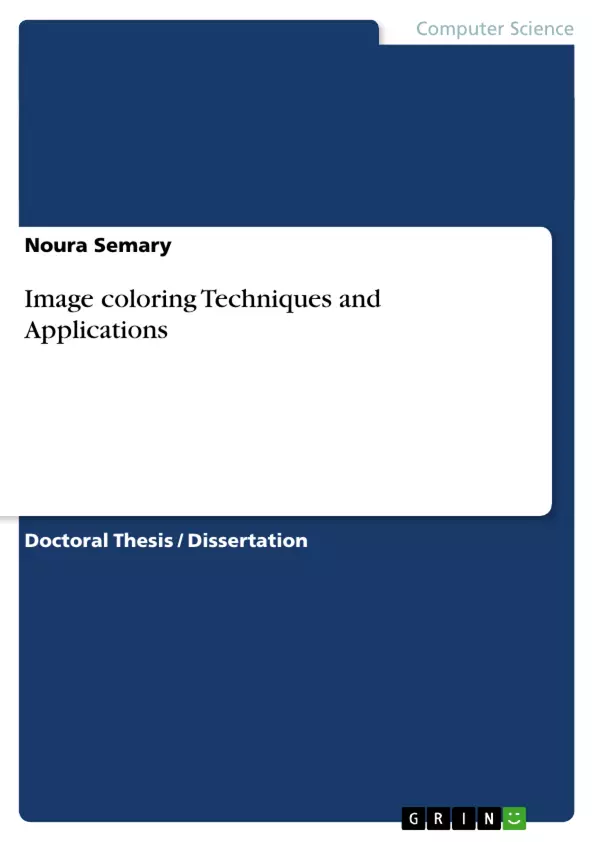After the appearance of Image Colorization in the literature and the different developments of colorization techniques, it was necessary to search for new applications for this new field rather than coloring gray images. This thesis is a research and implementation study for various applications that can exploit from colorization techniques. Three proposed colorization applications are proposed in this thesis; Automatic Movie Colorization System, Color Image Encoding System Using HSI Space Embedding System and Color Image Encoding System Using Morphological Decolorization. The first application of image colorization attracts researchers in this field is Old Movies Colorizing. This thesis presents a new proposal for a system that works on coloring the old movies automatically. The proposed system is based on coloring the film shot by shot instead of frames as it is common in this area. This is done by splitting the film into shots and coloring the first frame in the shot (the key frame) . After that the motion vector between the frames of each shot is generated to transfer the colors from the key frame to the following frames in the shot using the motion vector.
Color image encoding becomes an important application for image colorization. The idea is to remove colors from color images at the sender side while retaining the information about colors to enable image recolorization at the receiver side. The reason behind this methodology is to exploit from the smaller size of gray images. At
the receiver side, the colors are restored and the images are recolored. This Methodology of encoding is called Image Decolorization. The thesis presents two different approaches to color images decolorization: Color Embedding and Automatically Color Seeds Selection. A new system to compress the color channels in the color model "Hue, Saturation and Intensity" (HSI) is proposed. The encoded chromatic channels are hided inside the lighting channel using the “Least Significant Bit “(LSB) method. This is done by converting the Hue channel into objects and then to be encoded by an Object Compression method. For Saturation channel, there are two methods to compress S channel are proposed; "the Minimum Color Difference" (MCD) and "Y(Luma) Intensity Difference"(YID). The third proposed system is
a new automatic color seeds selection method based on Morphology . The seeds are extracted from the inner boundaries of image objects and hided in the luminance channel using LSB method.
Inhaltsverzeichnis (Table of Contents)
- CHAPTER ONE : INTRODUCTION
- 1.1DIGITAL IMAGE FUNDAMENTALS
- 1.2 COLORING PROBLEM:
- 1.3 COLORIZATION TECHNIQUES
- 1.4 DECOLORIZATION
- 1.5 RESEARCH OBJECTIVES
- 1.6 THESIS MOTIVATIONS
- 1.7 THESIS ORGANIZATION:
- CHAPTER TWO : LITERATURE SURVEY
- 2.1 COLORIZATION TECHNIQUE
- 2.1.1 Transformational Coloring
- 2.1.2 Image Matching /Coloring by Reference
- Manual Selection
- Intelligent Selection
- Fusion Based
- 2.1.3 User Selection/Colorization by Seeds
- 2.2 COLORIZATION APPLICATIONS
- 2.2.1 Movies Colorization
- 2.2.2 Medical Images Colorization
- 2.2.3 Color Image Compression
- 2.3 DECOLORIZATION TECHNIQUES
- 2.3.1 Automatic Seeds Selection
- 2.3.2 Color Embedding Decolorization
- CHAPTER THREE : MOVIE COLORIZATION SYSTEM
- 3.1 INTRODUCTION
- 3.2 PROPOSED MOVIE COLORIZATION SYSTEM
- 3.2.1 Shot Cut Detection Subsystem
- 3.2.2 Frame Colorization Subsystem
- 3.2.3 Motion Deteection subsystem
- Three Step Method (TSM)
- 3.2.4 Shot colorization subsystem
- 3.3 RESULTS AND DISCUSSION
- 3.3.1 Coloring Quality
- 3.4 MARKET RESEARCH
- 3.4.1 Processing Time
- 3.4.2 Market Need:
- 3.4.3 Market Demand:
- 3.4.4 Competing Products:
- CHAPTER FOUR: COLOR EMBEDDING FOR HSI MODEL
- 4.1 INTRODUCTION
- 4.2 THE PROPOSED COLOR ENCODING SYSTEM
- 4.2.1 Hue Proposed Encoder System
- Proposed Color Correction stage
- Segmentation stage
- Object Compression stage
- 4.2.2 Saturation Encoding Technique
- The Minimum Color Difference (MCD)
- Y(Luma) Intensity Difference (YID)
- 4.2.3 Intensity Encoding
- 4.3 RESULTS AND DISCUSSIONS
- 4.3.1 Other Quality Measures
- Objective Measures
- Subjective Measures:
- 4.3.2 More System Results:
- 4.4 COLOR EMBEDDING
- 4.4.1 Experiment (1) Using MCD
- 4.4.2 Experiment (2) Using YID
- CHAPTER FIVE: MORPHOLOGICAL DECOLORIZATION SYSTEM
- 5.1 INTRODUCTION
- 5.2 DECOLORIZATION USING MORPHOLOGY
- 5.3 SYSTEM QUALITY ASSESSMENTS
- 5.4 RESULTS AND DISCUSSIONS
- 5.4.1 Seeds Selection Evaluation
- 5.4.2 The System Compression Professionalism
- 5.4.3 Comparison With JPEG/JPEG2000
- 5.5 SEEDS HIDING
- CHAPTER SIX : CONCLUSION AND FUTURE WORKS
- 6.1 RESEARCH CONCLUSIONS
- 6.2 FUTURE WORKS:
- 6.2.1 Movies Colorization System Future Works
- 6.2.2 Color Embedding For HSI Model Future Work
- 6.2.3 Morphological Decolorization System Future Work
- APPENDIX A : COLOR MODELS
- A.1 COLOR FUNDAMENTALS
- A.2 COLOR MODELS
- A.2.1 RGB
- A.2.2 CMY/CMYK
- A.2.3 HSI/HLS
- A.2.4 HSV/HSB
- A.2.5 YIQ
- A.2.6 YUV
- A.2.7 CIE Lab/lαβ
- APPENDIX B: FUNDAMENTALS
- B.1 IMAGE CLUSTERING
- B.1.1 K-Means
- B.1.2 Accelerated K-Means
- Applying The Triangle Inequality
- B.1.3 K-Mean ++
- K-Means++ Algorithm :
- B.1.4 Mean Shift
- Mean shift filtering
- Mean shift Segmentation
- B.2 IMAGE COMPRESSION
- B.2.1 Huffman Coding
- B.2.2 JPEG Coding
- B.2.3 JPEG2000 Coding
- B.3 QUALITY ASSESSMENTS
- B.3.1 Objective Quality Assessments:
- MSSIM :
- Colorfulness Metric:
- B.3.2 Subjective Quality Assessment:
- B.4 FUNDAMENTALS OF MORPHOLOGY
- Dilation
- Erosion
- Opening
- Closing
- Skeletonization
- APPENDIX C: AWARDS AND CERTIFICATES
- C.1 PATENT ISSUE
- C.2 AWARDS
- C.3 PUBLICATIONS
- Quote paper
- Dr. Noura Semary (Author), 2011, Image coloring Techniques and Applications, Munich, GRIN Verlag, https://www.grin.com/document/205750



